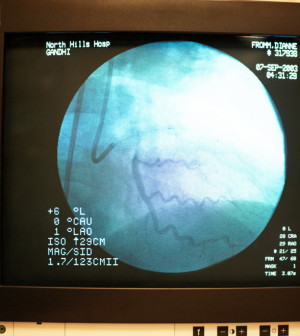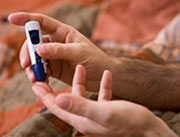- Skip Storing This Everyday Product in the Fridge Door
- Green Tea + B3 Pairing May Boost Brain Health
- Navigating Your Midlife Crisis: Embracing New Possibilities
- City Raccoons Showing Signs of Domestication
- Mapping the Exposome: Science Broadens Focus to Environmental Disease Triggers
- One Week Less on Social Media Linked to Better Mental Health
- Your Brain Changes in Stages as You Age, Study Finds
- Some Suicide Victims Show No Typical Warning Signs, Study Finds
- ByHeart Formula Faces Lawsuits After Babies Sickened With Botulism
- Switch to Vegan Diet Could Cut Your Greenhouse Gas Emissions in Half
Nearly 10 Percent of U.S. Adults Now Have Diabetes: Study


The percentage of Americans with diabetes has doubled since 1988, with nearly one in 10 adults now diagnosed with the blood-sugar disease, researchers report.
In the late 1980s and early 1990s, the rate of diagnosed and undiagnosed diabetes was 5.5 percent of the U.S. population. By 2010, that number had risen to 9.3 percent. That means 21 million American adults had confirmed diabetes in 2010, according to the researchers.
Several encouraging findings emerged from the study, however. A smaller proportion of people have undiagnosed diabetes, the report found, suggesting that newer screening techniques may be more efficient.
And the researchers found that overall blood sugar control was improved, although the disease was less well controlled in some minority groups.
“Diabetes has increased dramatically. The rates have almost doubled since the late ’80s and early ’90s,” said Elizabeth Selvin, the study’s lead author and an associate professor of epidemiology at the Johns Hopkins Bloomberg School of Public Health, in Baltimore.
“This study also highlights that the increase in diabetes really tracks closely with the epidemic of obesity. The diabetes epidemic is really a direct consequence of the rise in obesity,” Selvin said.
There are two main types of diabetes — type 1 and type 2. Type 2 diabetes is the far more prevalent type of diabetes, accounting for 90 percent to 95 percent of all diabetes, according to the National Diabetes Education Program.
Although both types of the disease result in higher-than-normal levels of blood sugar, the cause of each is different. Type 1 is an autoimmune disease, and its development is unrelated to weight. The exact cause of type 2 is unknown, but excess weight and a sedentary lifestyle are known to play a role in its development.
Poorly controlled diabetes poses serious health risks, including heart disease, kidney damage and blindness.
For the new study, the researchers used data from the National Health and Nutrition Examination Survey (NHANES), which included more than 43,000 adults followed from the first survey period (1988 to 1994) to the most recent (1999 to 2010).
In 1988 to 1994, the prevalence of diagnosed diabetes was 5.5 percent. By the next survey in 1999 to 2004, that number had risen to 7.6 percent. In the final survey, done from 2005 to 2010, the prevalence of diagnosed diabetes was 9.3 percent.
During that same time period, levels of obesity also rose. For people without diabetes, obesity rates rose from about 21 percent in the first survey to over 32 percent in the last. In those with diabetes, nearly 44 percent were obese during the first survey. That number rose to about 61 percent in the most recent survey.
Rates of prediabetes also increased dramatically from less than 6 percent to more than 12 percent over the study period. However, the number of people with undiagnosed diabetes leveled off during the study period, likely due to improved screening methods. Overall, the number of people with undiagnosed diabetes was reduced to 11 percent by 2010, according to the study.
Other news from the study was that blood sugar management improved among whites, although those gains weren’t seen in blacks or Mexican-Americans.
Results of the study appear in the April 15 issue of the Annals of Internal Medicine.
“The reality is that we know what to do to prevent type 2 diabetes, but doing it on a population level is an incredible challenge,” Selvin said. “There’s some evidence that the obesity epidemic may have plateaued, but combating the environment that contributes to obesity is an incredible difficulty.”
Dr. Martin Abrahamson, senior vice president for medical affairs at the Joslin Diabetes Center, in Boston, is a co-author of an accompanying editorial in the same issue of the journal.
“This article is a reminder that this problem isn’t going away; it’s only getting worse,” Abrahamson said.
Like Selvin, he acknowledged that knowing you need to lose weight and exercise more — and succeeding at making those changes — are a challenge.
“There are too many pushes and pulls in society that make it difficult for people to adhere to lifestyle regimens. Adhering to a healthy diet and exercising regularly have all shown benefit in reducing diabetes, hypertension [high blood pressure], weight and cholesterol,” Abrahamson said.
“So, how do you get people to embrace lifestyle changes?” he added. “It’s really going to take a multipronged effort that requires private and public institutions to really come together and develop a strategy to advance the message to live a healthy life.
“We also need to engage health-care professionals in doing a better job in counseling the benefits of lifestyle changes,” he said.
Abrahamson recommends walking 30 minutes a day at a brisk pace, and trying to lose 5 percent to 7 percent of your body weight to help prevent type 2 diabetes. This is especially important if you have been diagnosed with prediabetes.
Both Selvin and Abrahamson said the finding that overall blood sugar control has improved among whites, but not among minorities, suggests that more public health dollars — for prevention, raising awareness and increasing access to care — need to be targeted to minority communities.
More information
Learn more about preventing type 2 diabetes from the American Diabetes Association.
Source: HealthDay
Copyright © 2025 HealthDay. All rights reserved.










